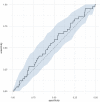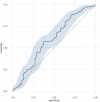SARS-CoV-2 viral load in nasopharyngeal swabs in the emergency department does not predict COVID-19 severity and mortality
- PMID: 33481307
- PMCID: PMC8014851
- DOI: 10.1111/acem.14217
SARS-CoV-2 viral load in nasopharyngeal swabs in the emergency department does not predict COVID-19 severity and mortality
Abstract
Introduction: The ongoing COVID-19 pandemic has led to devastating repercussions on health care systems worldwide. This viral infection has a broad clinical spectrum (ranging from influenza-like disease, viral pneumonia, and hypoxemia to acute respiratory distress syndrome requiring prolonged intensive care unit stays). The prognostic impact of measuring viral load on nasopharyngeal swab specimens (by reverse transcriptase polymerase chain reaction [RT-PCR]) is yet to be elucidated.
Methods: Between March 3 and April 5, 2020, we conducted a retrospective study on a cohort of COVID-19 patients (mild or severe disease) who were hospitalized after presenting to the emergency department (ED) and had at least one positive nasopharyngeal swab during their hospital stay. We led our study at the University Hospitals of Strasbourg in the Greater East region of France, one of the pandemic's epicenters in Europe.
Results: We have collected samples from a cohort of 287 patients with a confirmed diagnosis of COVID-19 who were included in our study. Nearly half of them (50.5%) presented a mild form of the disease, while the other half (49.5%) presented a severe form, requiring mechanical ventilation. Median (interquartile range) viral load on the initial upper respiratory swab at admission was 4.76 (3.29-6.06) log10 copies/reaction. When comparing survivors and nonsurvivors, this viral load measurement did not differ according to subgroups (p = 0.332). Additionally, we have found that respiratory viral load measurement was predictive of neither in-hospital mortality (adjusted odds ratio [AOR] = 1.05, 95% confidence interval [CI] = 0.85 to 1.31, p = 0.637) nor disease severity (AOR = 0.88, 95% CI = 0.73 to 1.06, p = 0.167).
Conclusion: Respiratory viral load measurement on the first nasopharyngeal swab (by RT-PCR) during initial ED management is neither a predictor of severity nor a predictor of mortality in SARS-CoV-2 infection. Host response to this viral infection along with the extent of preexisting comorbidities might be more foretelling of disease severity than the virus itself.
Keywords: COVID-19; mortality; nasopharyngeal swabs; severity; viral load.
© 2021 Society for Academic Emergency Medicine.
Conflict of interest statement
The authors have no potential conflicts to disclose.
Figures



Similar articles
-
SARS-CoV-2 infection: Initial viral load (iVL) predicts severity of illness/outcome, and declining trend of iVL in hospitalized patients corresponds with slowing of the pandemic.PLoS One. 2021 Sep 16;16(9):e0255981. doi: 10.1371/journal.pone.0255981. eCollection 2021. PLoS One. 2021. PMID: 34529675 Free PMC article.
-
Lower nasopharyngeal viral load during the latest phase of COVID-19 pandemic in a Northern Italy University Hospital.Clin Chem Lab Med. 2020 Jun 29;58(9):1573-1577. doi: 10.1515/cclm-2020-0815. Print 2020 Aug 27. Clin Chem Lab Med. 2020. PMID: 32598306
-
Cohort of Four Thousand Four Hundred Four Persons Under Investigation for COVID-19 in a New York Hospital and Predictors of ICU Care and Ventilation.Ann Emerg Med. 2020 Oct;76(4):394-404. doi: 10.1016/j.annemergmed.2020.05.011. Epub 2020 May 11. Ann Emerg Med. 2020. PMID: 32563601 Free PMC article.
-
[SARS-CoV-2 and Microbiological Diagnostic Dynamics in COVID-19 Pandemic].Mikrobiyol Bul. 2020 Jul;54(3):497-509. doi: 10.5578/mb.69839. Mikrobiyol Bul. 2020. PMID: 32755524 Review. Turkish.
-
Upper respiratory tract sampling in COVID-19.Malays J Pathol. 2020 Apr;42(1):23-35. Malays J Pathol. 2020. PMID: 32342928 Review.
Cited by
-
Protective immune trajectories in early viral containment of non-pneumonic SARS-CoV-2 infection.Nat Commun. 2022 Feb 23;13(1):1018. doi: 10.1038/s41467-022-28508-0. Nat Commun. 2022. PMID: 35197461 Free PMC article.
-
Association of high SARS-CoV-2 RNAemia with diabetes and mortality in critically ill COVID-19 patients.iScience. 2022 May 20;25(5):104075. doi: 10.1016/j.isci.2022.104075. Epub 2022 Mar 14. iScience. 2022. PMID: 35309726 Free PMC article.
-
Elevated Anti-SARS-CoV-2 Antibodies and IL-6, IL-8, MIP-1β, Early Predictors of Severe COVID-19.Microorganisms. 2021 Oct 29;9(11):2259. doi: 10.3390/microorganisms9112259. Microorganisms. 2021. PMID: 34835384 Free PMC article.
-
The relationship between COVID-19 viral load and disease severity: A systematic review.Immun Inflamm Dis. 2022 Mar;10(3):e580. doi: 10.1002/iid3.580. Epub 2021 Dec 13. Immun Inflamm Dis. 2022. PMID: 34904379 Free PMC article.
-
Cellular Immune Response to COVID-19 and Potential Immune Modulators.Front Immunol. 2021 Apr 30;12:646333. doi: 10.3389/fimmu.2021.646333. eCollection 2021. Front Immunol. 2021. PMID: 33995364 Free PMC article. Review.
References
MeSH terms
LinkOut - more resources
Full Text Sources
Other Literature Sources
Medical
Miscellaneous

